|
|
|
Sort Order |
|
|
|
Items / Page
|
|
|
|
|
|
|
| Srl | Item |
| 1 |
ID:
185096
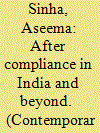

|
|
|
|
|
| Summary/Abstract |
Using India as a theory building case, this paper puts forward a theoretical framework for understanding countries’ responses to global rules and implementation effects across diverse global governance regimes and contexts. The initial premise for this paper is that the strategic structure of implementation dilemmas faced by states and actors within countries need to be understood in addition to design dilemmas. Successful global regimes must not only solve cooperation and uncertainty problems at the initial stages in choosing the right institutional matrix, but also ‘require changes in domestic institutions.’ The need to change domestic institutions creates certain implementation dilemmas. These dilemmas are a joint product of the institutional design, specific policy issue and the domestic logic of responses after international agreements have been signed. This broader idea helps understand a wide variety of India’s interactions across global governance institutions. I also suggest a novel empirical strategy of cross-institutional analysis to assess implementation dilemmas. While we have numerous cross-national studies of how compliance occurs in a wide variety of countries, we lack theory-driven, empirically grounded, comparative studies of a single country or a group of countries across diverse global regimes. Such a framework can help us better understand how countries interact with a variety of global institutions and the reciprocal effects. This framework is then used to understand India’s interactions with diverse global regimes in an illustrative manner in this article, and in greater detail by other authors in the section published in this issue of Contemporary South Asia.
|
|
|
|
|
|
|
|
|
|
|
|
|
|
|
|
| 2 |
ID:
160050
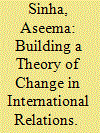

|
|
|
|
|
| Summary/Abstract |
Fundamental transformations in the distribution of power among nations have re-focused the attention of the International Relations (IR) subfield on how to understand change and power transitions. I add to this larger literature by presenting a typology of change drawn from comparative politics that incorporates attention to incremental or slow moving change, and path-dependence as a theoretical tool to explain discontinuous change such as wars, and the fall of the former Soviet Union. I offer a distinction between process of change and its outcome. Change may be incremental or disruptive and could lead to continuity with existing institutions or their transformation. This typology allows us to explore the process of change and develop theories of change in a new way. In essence, I argue for broadening our conceptions of change to account for endogenous sources of change (internal to the system), and incremental yet significant change.
|
|
|
|
|
|
|
|
|
|
|
|
|
|
|
|
| 3 |
ID:
052071
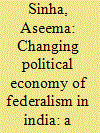

|
|
|
|
|
| Publication |
Jan 2004.
|
| Summary/Abstract |
India's economic reform program started in 1991, unleashing a process of decentralization and competitive race among its regional states. Yet the post-reform era in India is marked by both change and continuity in terms of center-state economic relations. Attention to the path and process of reform must attend to the reform legacies of the ancien regime and how they are transformed over time. I show that the pre-reform era was characterized not by an absence of competition, but by a different type of competition among states. A historical institutional framework shows that policy change in India transforms the existing balance of power, but does so shaped by the preexisting institutional context and preexisting linkages, resources, and skills. This approach, allows us to integrate an analysis of pre-1991 policy regime into evaluations of the post-1991 changes in a more cohesive, realistic, and yet nuanced manner.
|
|
|
|
|
|
|
|
|
|
|
|
|
|
|
|
| 4 |
ID:
180898
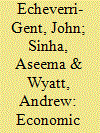

|
|
|
|
|
| Summary/Abstract |
Narendra Modi came to power in 2014 promising robust economic management and more employment. The campaign promise of “maximum governance, minimum government,” created hope that Modi would transform India’s economy by removing obstacles to growth and job creation. We assess the Modi government’s economic policies from 2014–2019 focusing on salient initiatives like demonetization, bankruptcy law, GST reforms, and “Make in India.” We argue that Modi’s economic policies must be understood, first and foremost, as a political strategy to build political support and ensure the BJP’s hegemony through the next decade. In addition, we show that Modi’s success in building his personal image as a decisive leader perversely triggered institutional changes such as centralization of decision-making and political management of information that diminished India’s state capacity and led to policies that failed to address, and in many cases exacerbated, India’s economic problems.
|
|
|
|
|
|
|
|
|
|
|
|
|
|
|
|
| 5 |
ID:
185095
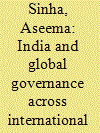

|
|
|
|
|
| Summary/Abstract |
India’s rising power and status within a variety of global institutions is well explained with the help of an inside-out approach, with a focus on India’s domestic compulsions and strategies. This special section of four articles in Contemporary South Asia deepens this inside-out analysis, combining it with an outside-in approach to global institutions which explore how the global regime in question shapes and interacts with domestic impulses and dilemmas. The four papers explore India’s approach and actions across a divergent set of global institutions such as the IMF, the WHO, and maritime governance in a regional context, showing how the institutional and geopolitical context matters to understanding India’s diverse actions and strategies. These articles also explore the evolving process of compliance and implementation within each specific global institutional context. Such a comparative approach allows us to understand how the specific institutional design of the relevant organization or the structure of the global regime affects India. In this introduction to the special section, I outline the advantages of an interactive, comparative approach, exploring India’s varying actions across a variety of issue areas and global contexts. Such a variegated and differential analysis across global regimes is valuable for a more complete and differentiated analysis of India’s rise.
|
|
|
|
|
|
|
|
|
|
|
|
|
|
|
|
| 6 |
ID:
064207
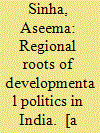

|
|
|
|
|
| Publication |
Bloomington, Indiana University Press, 2005.
|
| Description |
xxiii, 356p.
|
| Series |
Contemporary Indian studies
|
| Standard Number |
0253216818
|
|
|
|
|
|
|
|
|
|
|
|
Copies: C:1/I:0,R:0,Q:0
Circulation
| Accession# | Call# | Current Location | Status | Policy | Location |
| 049818 | 338.954/SIN 049818 | Main | On Shelf | General | |
|
|
|
|
| 7 |
ID:
165085
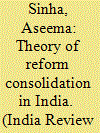

|
|
|
|
|
| Summary/Abstract |
use the policy feedback literature to present an argument regarding the new politics of reform consolidation in India. India’s reform trajectory can be understood in terms of three distinct phases of reforms interspersed by periods of slowdown. In this narrative that goes beyond 1991, an analysis of struggles, opponents, and reversals become important, revealing a more contested pathway. In the 2000s India has moved beyond the initial, crisis-driven phase to a deeper external integration with the global economy and structural reform within. I call this phase an era of strategic internationalization. Reforms of 1985, 1991, and 1998–2000, in different ways, have begun to create new constituencies of support across India, which underlies the consolidation phase of reforms. During this long trajectory, the opponents of reforms could delay reforms but failed to reverse the direction of economic reforms. The purpose of this article is to provide a temporal framework that pays attention to mechanisms underlying different phases of reforms and how new supporters and opponents of reforms were created across different phases of the reform trajectory. Policies, the social bases of the Indian economy, and classes have been re-configured as a result.
|
|
|
|
|
|
|
|
|
|
|
|
|
|
|
|
| 8 |
ID:
153840
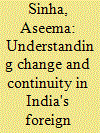

|
|
|
|
|
| Summary/Abstract |
The field of Indian foreign policy is rich and wide ranging, offering new empirical material across a broad array of topics and relationships. This article reviews three recent books on the subject, with an eye towards evaluating change amid continuity in the pursuit of Indian foreign policy. This scholarship calls out for a new paradigm to understand India's changing position and actions at global, regional and domestic levels. I argue that Indian foreign policy can and should be seen through the prism of an open border, interdependence framework, wherein both the domestic and global levels are analysed in a linked manner. While the literature surveyed here does not yet offer a new paradigm, some common findings suggest the need for newapproaches. We also need to find and use new sources of data and seek ways to measure institutional effects in foreign policy. The task of measurement and theoretical modelling is made more challenging by the need to theorize the linkages across levels and to measure foreign policy variables in different countries simultaneously.
|
|
|
|
|
|
|
|
|
|
|
|
|
|
|
|
| 9 |
ID:
180375
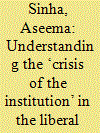

|
|
|
|
|
| Summary/Abstract |
The liberal trade order is in crisis. I argue that the origins of the current crises lie in the underlying tension which exists in the World Trade Organization (WTO), magnified by a churning in global power dynamics. A dilemma at the heart of the WTO between two important goals of representativeness and effectiveness means that both goals cannot be pursued at the same time. Now, this inherent tension is being magnified by power shifts in the global economy most evident in the rise of emerging powers within the WTO, who demand more representation, and the retreat by the US towards a more inward-looking orientation; both together damage effectiveness. Simultaneously, new powers such as China and India are defending a ‘reformed multilateralism’ combined with selective protectionism with varying capacity. These shifts are transforming previous ‘crises within institutions’ into a ‘crisis of institutions’ at the WTO, wherein the rules of the game, ideas of free trade and the legitimacy of the WTO are under threat. Global trade politics is seeing new coalitions at the WTO, as emerging powers craft their own rise, US defends sovereignty and trade protections, and launches a challenge to China's rise, and some established powers (the EU for example) seek to reform it. The new global trade politics is walking on two uneven legs and creating winners and losers and new ways of managing the transitional trading order as did the creation of the post-world war order.
|
|
|
|
|
|
|
|
|
|
|
|
|
|
|
|
| 10 |
ID:
193624
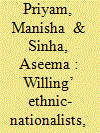

|
|
|
|
|
| Summary/Abstract |
Using evidence regarding the consolidation of Hindu nationalism in India we put forward new ethnographic data about the variety of popular support for a Hindutva project and a new framework that proposes an interactive theory of social identity. This framework helps us understand how Hindu nationalism becomes embedded in society. We assert that Hindu nationalism in India could be fruitfully analysed by focusing on the processes through which ideas of exclusive nationalism spread among ordinary middle-class people and are expressed in micro-level psychological changes at the individual level. The consolidation of Hindu nationalism in India is being authored not only by parties or the state, but also by societal actors, specifically, ordinary middle-class Indians. Hindu nationalism has been spreading in micro-public spheres in a time of apparent peace and between elections, and with the participation of willing supporters. Building on our fieldwork and research in psychology and history, our conversations have also helped us to identify profiles of different types of nationalists, which we categorize as willing ethnic-nationalists, hardliners, bystanders, and moderates. Further, we suggest the need to focus on inter-linked micro-level mechanisms such as diffusion and emulation of Hindu-centric beliefs and ideas, mobilization by hardliners and organizations, and impunity resulting from protection by state agencies, which helps to create willing ethnic-nationalists and sustains Hindu nationalism. Evidence regarding social interactions from a variety of survey organizations concurs with our findings and our ethnographic material allows us to delve deeper into varieties of Hindu nationalist support across diverse ordinary people.
|
|
|
|
|
|
|
|
|
|
|
|
|
|
|
|
|
|
|
|
|